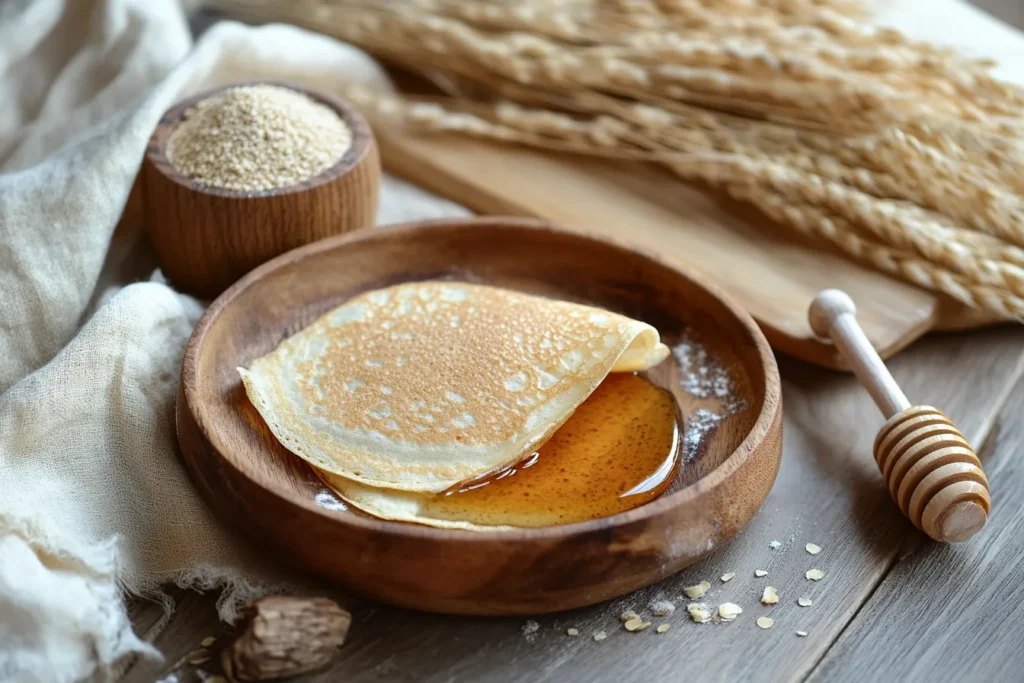Have you ever craved the delicate, melt-in-your-mouth goodness of crepes, only to feel stuck because you’re avoiding gluten? You’re not alone. Finding gluten-free alternatives that actually taste just as good as the real thing can feel like a challenge, especially when it comes to something as classic as crepes. But here’s the good news: gluten-free crepes can be just as light, flexible, and delicious as their traditional counterparts—without the guesswork. Whether you’re gluten-intolerant, celiac, or just looking for a healthier option, this recipe is your solution. I get it—sometimes you just want a breakfast or dessert that feels fancy without being overly complicated. So let’s roll up (or fold!) some gluten-free crepes together—you’ll be amazed at how easy and satisfying they are!
List Of Contents
Introduction to Gluten-Free Crepes
What are gluten-free crepes? Gluten-free crepes are a delightful alternative to traditional crepes, crafted to suit those with gluten intolerance or anyone seeking healthier meal options. They are thin, delicate pancakes made without wheat flour, ensuring a tasty treat that aligns with gluten-free dietary needs.
Why choose gluten-free crepes?
- They are suitable for those with celiac disease or gluten sensitivity.
- Perfect for health-conscious eaters seeking a lighter alternative.
- Easily customizable for sweet or savory preferences.
Gluten-free crepes are worth exploring, whether you’re new to cooking or an experienced home chef. Check out more recipes here.
The History of Crepes
Crepes originated in Brittany, a region in France. The term “crêpe” comes from the Latin word crispa, meaning curled, which hints at the light, folded nature of these pancakes.
Key Highlights:
- French Heritage: Initially crafted from buckwheat, crepes evolved into a cornerstone of French cuisine.
- Global Popularity: From savory galettes to sweet dessert crepes, these adaptable pancakes have gained recognition worldwide.
The use of gluten-free ingredients has transformed crepes into a contemporary culinary trend. Learn about variations of crepes and their diverse preparation styles.
Understanding Gluten-Free Diets

What Does Gluten-Free Mean?
A gluten-free diet refers to excluding the protein gluten, which is commonly found in wheat, barley, and rye. Gluten is a binding protein that provides elasticity to dough but can cause health problems for some individuals. For this reason, adopting a gluten-free lifestyle is crucial for managing specific medical conditions. Moreover, it can also benefit those looking to improve digestion and overall well-being. By eliminating gluten, individuals can enjoy a diet that is both healthier and more suitable for their needs.
Who Benefits from a Gluten-Free Lifestyle?
- Celiac Disease Sufferers:
- For individuals with celiac disease, consuming gluten triggers severe immune responses that damage the small intestine. As a result, this can lead to malabsorption of nutrients, fatigue, and other health complications. Therefore, a gluten-free diet is not just beneficial but essential for managing this condition.
- People with Gluten Sensitivity:
- For those who are gluten-sensitive but do not have celiac disease, a gluten-free diet helps alleviate symptoms like bloating, abdominal pain, and fatigue. In other words, it improves comfort and quality of life without the need for medical intervention.
- Health Enthusiasts:
- Many health-conscious individuals adopt a gluten-free lifestyle to promote better digestion and maintain higher energy levels. Furthermore, avoiding gluten can help reduce inflammation, leading to improved gut health and overall wellness.
Overall, a gluten-free diet provides various benefits tailored to individual health requirements. Whether it’s for medical reasons or a proactive health approach, gluten-free living can be a positive change for many.
Common Challenges in Making Gluten-Free Crepes
Crafting the perfect gluten-free crepe can be daunting due to the absence of gluten, which is vital for elasticity. Challenges include:
- Texture Issues: Ensuring crepes remain soft yet sturdy.
- Consistency Problems: Achieving a lump-free batter.
Benefits of Gluten-Free Crepes
Opting for gluten-free crepes offers several advantages:
- Dietary Flexibility: Ideal for people with allergies or dietary restrictions.
- Digestive Ease: Easy on the stomach, making it a preferred choice for many.
Explore why gluten-free foods are on the rise and how they improve overall health.
Key Ingredients for Gluten-Free Crepes
Choosing the right ingredients is crucial. Popular options include:
- Gluten-Free Flours: Almond, rice, coconut, or oat flour.
- Binders: Xanthan gum or psyllium husk for structural integrity.
Pro Tip: Experimenting with different flour combinations enhances flavor and texture.
Essential Tools for Crepe-Making
Success lies in the right tools:
- Non-Stick Pans: Prevent sticking and ensure even cooking.
- Crepe Spreaders: Achieve thin, uniform layers.
- Spatulas: For gentle flipping without breakage.
Types of Gluten-Free Crepe
- Sweet Crepes: Perfect for desserts, paired with fillings such as berries, Nutella, or whipped cream.
- Savory Crepes: Packed with spinach, cheese, or smoked salmon for hearty meals.
Importance of Proper Technique

Mastering crepes requires:
- Thin Layers: Spread batter evenly for delicate crepes.
- Smooth Batter: Avoid lumps by sifting dry ingredients and whisking thoroughly.
Substitutes for Traditional Crepe Ingredients
Switching to gluten-free doesn’t mean compromising taste. Try these:
- Milk Alternatives: Almond, oat, or coconut milk.
- Egg Replacements: Use chia seeds, flax eggs, or aquafaba for vegan options.
Classic Gluten-Free Crepe Recipe
Crafting flawless gluten-free crepes begins with a reliable recipe. Here’s a step-by-step guide for beginners:
Ingredients:
- 1 cup almond flour or rice flour
- 2 large eggs (or flax eggs for vegan options)
- 1 cup of your preferred milk, such as almond, oat, or cow’s milk.
- 2 tablespoons melted butter or coconut oil
- A pinch of salt
- 1 teaspoon vanilla extract (optional for sweet crepes)
Instructions:
- In a bowl, combine the flour, eggs, milk, butter, and salt, whisking until the mixture is smooth. Rest the batter for 20 minutes.
- Preheat a non-stick pan on medium heat and apply a light layer of grease.
- Pour a small ladle of batter into the pan, swirling to coat the surface thinly.
- Cook for about 1-2 minutes until edges lift, then flip carefully and cook for another 30 seconds.
Tips for Beginners:
- Resting the batter helps hydrate the flour, improving texture.
- Use a ladle for consistent portioning.
Sweet Gluten-Free Crepes
Sweet crepes open endless possibilities for indulgence. Popular fillings include:
- Fresh fruits like strawberries, bananas, or blueberries.
- Spreads like Nutella, peanut butter, or cream cheese.
- Toppings like powdered sugar, honey, or maple syrup.
Flavor-Enhancing Techniques:
- Add a splash of orange zest to the batter for citrusy notes.
- Incorporate a pinch of cinnamon for warmth and depth.
Satisfy your sweet tooth with these versatile crepes, perfect for breakfast or dessert.
Savory Gluten-Free Crepes
Savory gluten-free crepes are a fantastic choice for hearty breakfasts, quick dinners, or even a satisfying brunch. Their versatility allows you to fill them with endless combinations of flavors, making them suitable for any occasion. With the right ingredients, they can be both nutritious and indulgent.
Best Combinations:
- Spinach and Cheese: This classic vegetarian filling combines sautéed spinach with melty cheese like mozzarella, Gruyère, or feta. To enhance the flavor, add a pinch of nutmeg or black pepper.
- Chicken and Mushroom: A protein-packed option featuring tender chicken breast and creamy mushroom sauce. Additionally, consider adding garlic or thyme for a more robust taste.
- Eggs and Avocado: Perfect for a keto-friendly meal, this combination blends the creaminess of avocado with the richness of scrambled or poached eggs. For added texture, sprinkle with sesame seeds or chili flakes.
Pro Tip:
Experiment with herbs like dill, parsley, or chives by mixing them directly into the crepe batter. This simple addition infuses your crepes with fresh, aromatic flavors, making them even more delicious.
By trying these combinations and tips, savory gluten-free crepes can become your go-to recipe for satisfying meals that cater to various tastes and dietary needs or. Explore savory crepe ideas for inspiration.
Vegan Gluten-Free Crepes

Vegan crepes may seem tricky without eggs or dairy, but the right substitutes can deliver exceptional results.
Key Adjustments:
- Replace eggs with flaxseed meal (1 tablespoon flaxseed + 2.5 tablespoons water = 1 egg).
- Use plant-based milk and coconut oil for richness.
Achieving Texture:
- Add a teaspoon of apple cider vinegar to mimic the binding properties of eggs.
Paleo-Friendly Gluten-Free Crepes
For those following a paleo lifestyle, nut flours are an excellent choice.
Recipe Modifications:
- Use almond flour or cassava flour for a low-carb alternative.
- Sweeten with honey or dates instead of sugar.
These crepes align with the paleo philosophy of avoiding processed ingredients, offering a nutritious, guilt-free option.
High-Protein Gluten-Free Crepes
Adding protein to your gluten-free crepes transforms them into a nutritious, post-workout snack or a satisfying meal. By incorporating protein-rich ingredients, you can make your crepes both delicious and supportive of your fitness goals.
How to Incorporate Protein:
- Replace 1/4 of the flour: Use vanilla or unflavored protein powder to boost the nutritional value without compromising texture. Additionally, ensure the powder blends well with other ingredients to avoid lumps.
- Combine with nut butter or Greek yogurt: Spread nut butter like almond or peanut on the crepes, or serve them with a dollop of Greek yogurt. Moreover, topping with fruits adds natural sweetness and extra vitamins.
Discover more protein-packed meal ideas to keep you energized throughout the day while enjoying your gluten-free creations.
How to Make Crepe Batter in Advance
Busy mornings can be simplified by preparing your crepe batter ahead of time. With proper storage, you’ll always have crepe batter ready to go, saving time and reducing stress.
Storage Tips:
- Refrigerate: Store batter in an airtight container for up to 2 days to maintain freshness.
- Stir before use: Redistribute any settled ingredients to ensure the batter remains smooth and consistent.
Reviving Stored Batter:
If the batter thickens after refrigeration, add a splash of water or milk to restore its ideal pouring consistency. This small adjustment ensures your crepes remain thin and delicate.
Flipping and Cooking Techniques
Flipping crepes is often the most challenging step, but with the right techniques, you can master it effortlessly.
Steps for Success:
- Cook until edges curl slightly: This indicates the crepe is ready to flip.
- Slide a spatula gently under the crepe: Loosen the edges first to avoid tearing.
- Use your wrist for a quick, smooth motion: A confident flip ensures the crepe lands flat and cooks evenly on the other side.
With practice and these tips, flipping crepes will feel second nature, leading to perfectly cooked gluten-free crepes every time!
Tips for Perfectly Thin Crepes
Achieving that delicate, paper-thin texture involves precision:
- Use a crepe spreader or tilt the pan immediately after pouring the batter.
- Ensure the batter consistency is slightly runny.
Learn professional crepe techniques for consistent results.
Troubleshooting Gluten-Free Crepes
Even seasoned chefs encounter issues. Here’s how to troubleshoot:
Common Mistakes:
- Batter too thick: Add a small amount of milk to adjust.
- Crepes breaking: Incorporate an extra egg or binder like xanthan gum.
Quick Fixes:
- Use a well-heated, greased pan to prevent sticking.
- Rest the batter longer for improved elasticity.
Gluten-Free Crepes: Serving and Presentation
Serving Gluten-Free Crepes
Serving crepes is truly an art, requiring a balance between flavor and aesthetics. Whether you’re crafting sweet delights or savory creations, thoughtful presentation can elevate the dining experience to a whole new level. With the right pairings and plating, your gluten-free crepes can become a feast for both the palate and the eyes.
Pairing Suggestions:
- For Sweet Crepes: Pair these with fresh fruits like strawberries, bananas, or blueberries, and add a dollop of whipped cream or a drizzle of chocolate syrup. Furthermore, consider incorporating toppings like honey or powdered sugar for a classic dessert finish.
- For Savory Crepes: Complement savory crepes with fresh salads, roasted vegetables, or dipping sauces such as garlic aioli or herb yogurt. Additionally, pair them with hearty sides like roasted potatoes for a filling meal.
Pro Tip:
Fold or roll your crepes neatly to create a polished look. To enhance their appeal, sprinkle powdered sugar for sweet crepes or garnish savory ones with fresh herbs like parsley or dill. These small details add an elegant touch that makes your dish truly memorable.
Popular Gluten-Free Crepe Toppings

Toppings can transform a simple crepe into a culinary masterpiece, offering a delightful combination of flavors and textures. Whether sweet or savory, choosing the right toppings enhances both the taste and presentation of your dish. Here are some ideas:
Sweet Toppings:
- Chocolate ganache or Nutella: Perfect for indulgence and creating a decadent dessert. Additionally, pair these with a dollop of whipped cream for an extra treat.
- Fresh berries, bananas, or kiwi: These options add a burst of natural flavor and color, making your crepes not only delicious but visually appealing. Moreover, they provide a healthy twist to your sweet creations.
- Maple syrup or honey: Ideal for those who prefer a natural sweetness. Furthermore, these toppings blend well with butter or a sprinkle of cinnamon.
Savory Toppings:
- Grated cheese like Gruyère or feta: These cheeses melt beautifully and complement a variety of savory fillings. In particular, they pair well with eggs or vegetables for a balanced meal.
- Sautéed mushrooms, spinach, or caramelized onions: These toppings bring a savory depth of flavor and can be layered together for a hearty filling. Additionally, they offer a great way to include vegetables in your meal.
- Protein-rich options like shredded chicken or smoked salmon: These make your crepes satisfying and nutrient-rich. For instance, combine smoked salmon with a dollop of cream cheese for a gourmet experience.
With these ideas, your gluten-free crepes can cater to any palate and occasion, ensuring a memorable dining experience every time!
Making Crepes a Family Activity
Preparing crepes can easily become a fun and engaging family tradition. By involving everyone in the process, you can create lasting memories while enjoying delicious results. Here are a few ways to make it an interactive activity:
- Let kids customize their crepes: Encourage creativity by providing colorful toppings such as fresh fruits, sprinkles, or sauces. Additionally, let them experiment with sweet and savory combinations to discover their favorites.
- Host a DIY crepe bar: Set up a station with various fillings like Nutella, whipped cream, shredded cheese, and sautéed vegetables. Moreover, offering a wide range of options ensures everyone finds something they love.
- Teach older children how to flip crepes safely: Flipping crepes can be exciting and rewarding. Take it step-by-step, showing them the proper wrist motion and ensuring they use heat-resistant tools.
Pro Tip: Use small pans to create child-friendly portions that are easy to handle. Also, consider offering allergen-free ingredients to accommodate dietary restrictions and make the activity inclusive for all family members.
With these ideas, crepe-making becomes more than just a cooking task—it becomes a joyful bonding experience!
Gluten-Free Crepes for Special Occasions
Ideas for Themed Crepes:
- Christmas: Red and green fillings like strawberry and kiwi.
- Easter: Sweet crepes with pastel-colored sprinkles.
- Birthdays: Dessert crepes with ice cream and rainbow toppings.
Create crepe platters with both sweet and savory varieties for crowd-pleasing results.
Customizing Crepes for Dietary Need
One of the best features of gluten-free crepes is their adaptability. Customize for various dietary needs:
- Low-Sugar Options: Use unsweetened applesauce or stevia.
- Allergy-Friendly Fillings: Choose nut-free butters or seed-based alternatives.
- Keto-Friendly: Opt for coconut flour and high-fat fillings like avocado.
Crepe Storage and Reheating
Storage Best Practices:
- Cool completely before stacking to avoid sticking.
- Place parchment paper between crepes.
- Keep in an airtight container in the refrigerator for up to 3 days.
Reheating:
- Microwave for 20-30 seconds.
- Heat in a non-stick pan on low for a crispy edge.
Pairing Beverages with Crepes
Pairing beverages enhances the overall experience:
- Coffee and Tea: A latte enhances sweet crepes, while green tea pairs nicely with savory ones.
- Juices: Freshly squeezed orange juice provides a refreshing complement.
- Sparkling wines such as Prosecco complement sweet crepes, whereas dry whites match well with savory varieties.
International Crepe Styles
Crepes are enjoyed in many culinary traditions, and making them gluten-free increases their accessibility and showcases their adaptability. From traditional recipes to modern twists, gluten-free crepes fit seamlessly into diverse culinary traditions.
Popular Variations:
- French Crepes: These traditional thin crepes are often filled with savory ingredients like ham and cheese or sweet options like chocolate and fresh fruit. Notably, French galettes made with buckwheat flour are naturally gluten-free and perfect for this adaptation.
- Russian Blinis are denser and resemble pancakes more closely, often served with sour cream, smoked salmon, or caviar.. When made with gluten-free flour, they retain their hearty texture and unique taste.
- Japanese Crepes are famous for their artistic display, rolled into cones and filled with cream, fruits, or savory options like teriyaki chicken.
Additionally, their visual allure makes them popular at cafes and street vendors.
How to Adapt:
To keep the traditional taste while adapting crepes to be gluten-free, incorporate flours typical to the region:
- For French Crepes: Buckwheat flour works perfectly for savory galettes. Additionally, it adds a nutty flavor that enhances the dish.
- For Russian Blinis, blending gluten-free flour with potato starch can mimic the original dense texture.
- For Japanese Crepes, rice flour works well to achieve the characteristic soft and flexible texture.
By exploring these adaptations, you can enjoy crepes inspired by global cuisines while keeping them gluten-free and delicious!
Popular Gluten-Free Crepe Brands
Sometimes, convenience is key. Several brands offer ready-made gluten-free crepes or mixes:
- Bob’s Red Mill: Known for versatile gluten-free crepe mixes.
- Crepini: Pre-made crepes ideal for quick meals.
- King Arthur Baking Company provides premium gluten-free flour mixes for homemade baking.
Health Benefits of Gluten-Free Crepes
Choosing gluten-free crepes offers more than just dietary compliance. They’re packed with nutrients depending on the ingredients:
- Rich in Fiber: Flours like almond or oat boost fiber intake.
- Energy-Boosting: Perfect as a pre-workout meal when paired with fruits or proteins.
- Allergen-Friendly: Eliminates common irritants for sensitive stomachs.
FAQs
1. Can gluten-free crepes be made in a waffle maker?
Yes, with thicker batter, gluten-free crepes can double as waffles.
2. What’s the best gluten-free crepe for diabetics?
Use almond flour and sugar substitutes like monk fruit or stevia.
3. Can I double the gluten-free crepe recipe for large groups?
Absolutely! Just maintain the batter’s consistency as you scale.
4. Are gluten-free crepes kid-friendly?
Yes, especially with fun fillings like chocolate spread or peanut butter.
5. Do gluten-free crepes take longer to cook?
Not significantly, though they may need an extra 30 seconds due to flour density.
6. How can I make crispy gluten-free crepes?
Cook over medium-high heat for slightly longer until edges are golden.
7. Can I make crepes with quinoa flour?
Yes, but combine it with a neutral flour like rice for better flavor.
8. Do gluten-free crepes freeze well?
Yes, freeze individually with parchment paper between each.
9. How do I prevent gluten-free crepes from drying out?
Cover with a damp cloth until serving to retain moisture.
10. What’s the shelf life of homemade gluten-free crepe batter?
It stays fresh in the fridge for up to 48 hours.
11. Can I freeze gluten-free crepes?
Yes, stack them with parchment paper in between, then store in an airtight container.
12. How do I reheat frozen crepes?
Warm in a non-stick pan or microwave for 30 seconds.
13. Are gluten-free crepes healthier than regular crepes?
They’re often easier to digest and can be made with nutrient-rich flours.
14. What’s the best gluten-free flour for crepes?
Almond flour is great for texture; rice flour works well for a neutral taste.
15. Can I make gluten-free crepes without eggs?
Yes, use flaxseed meal, aquafaba, or commercial egg replacers.
16. How do I prevent crepes from sticking to the pan?
Always use a greased, non-stick pan and ensure it’s properly heated.
17. Are gluten-free crepes keto-friendly?
If made with almond or coconut flour, they can be.
18. Can I use store-bought gluten-free flour blends?
Yes, but check for added binders like xanthan gum.
19. Do gluten-free crepes taste different?
They may have a nuttier flavor, depending on the flour used.
20. What is the calorie count of gluten-free crepes?
It varies based on ingredients, but typically ranges from 80-150 calories per crepe.
